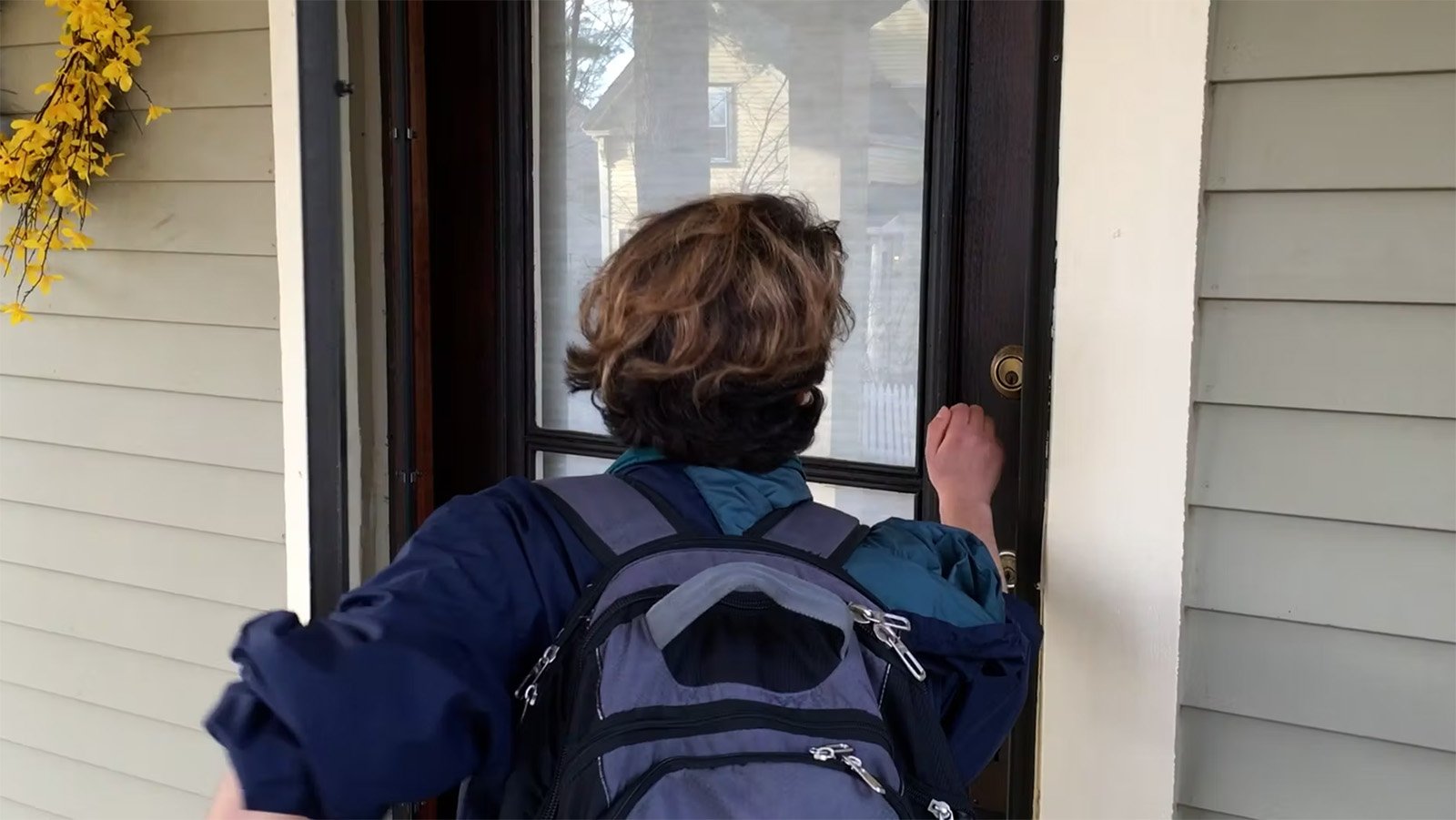
Bringing democracy to your doorstep
120 million doors knocked, 16.5 million donations received, $1.2 billion raised and counting
Why we canvass
Over 40 years, there have been many reasons why PIRG and the Fund have spent so much time and energy on perfecting the craft of canvassing citizens for support, action and giving.
A dramatic increase in funds
If you’ve ever canvassed for a cause, you know that one primary purpose of going door to door is fundraising.
Since 1980, canvassing helped dramatically increase the budget of the PIRGs, leading to an increase in the number of PIRG staff and the number of projects and campaigns undertaken or spun off by PIRG. Among them: in 1982, the Fund for the Public Interest; in 1983, a national lobbying office, U.S. PIRG; in 1984, the National Student Campaign for Voter Registration (now New Voters Project); in 1985, the National Environmental Law Center and the National Student Campaign Against Hunger and Homelessness. And so forth over the years — Toxics Action Center (now Community Action Works), more states with PIRG offices and state environment group offices, Green Corps, Green Century Funds, Frontier Group, Environment America, Fair Share, Community Voters Project, Environmental Action, and the rest. All this was made possible by the members recruited, and money raised, by the canvasses.
Educating the public
There’s no shortage of information in today’s world, but not everybody engages in conversation about social problems, how we can solve them, and what people can do to bring about change. Canvassers bring these conversations directly to the people, unfiltered by media or other “bubbles” that leave people unaware of new information or points of view.
Over 40 years, PIRG and Fund canvassers have held millions of these conversations with the American people, about a broad range of issues including recycling, toxic chemicals, clean water, clean air, our national forests, wildlife, Wall Street reform, campaign finance reform, plastic pollution, clean energy and more.
The power of membership
Canvassing has also formed an important new power base for PIRG and other groups in The Public Interest Network.
For starters, there is inherent value in public interest organizations that are driven by the voluntary association of ordinary people as members. We’ve also motivated many of our members to take action and, in so doing, to become, whether consciously or not, activists.
And make no mistake, this grassroots action is the only thing that pushes campaigns over the goal line. No matter how many facts PIRG or other groups have on our side, the powerful interests on the other side of the issue will always win unless legislators see that their constituents care about an issue.
Democracy in the streets
Four decades later, there are now easier ways to reach people than piling into a car, driving to "turf" and knocking on doors. Yet it’s hard to beat face-to-face interaction when it comes to reinvigorating our democratic culture.
Canvassers go out there and talk to people about an issue, a program, which they can accept or reject, but even when they hustle the canvasser off their doorstep, we give them something to think about. The person at the door goes from spectator to participant, even if, sometimes, in the most minor way.
For the person who joins, their decision involves them more in civic life and makes democracy a little bit more real. But even for the person who says no, that person has to go back inside and know that there was someone out there, perhaps in the rain or snow and usually in the dark, who could be doing something easier and more remunerative, but who cares about something larger than themselves. And in that moment, maybe, we sense some progress.
Video credit: Staff

A new base of support
It was May 22, 1980, when Ken Ward, Nancy Reiner, Steve Kaplan and John Walbur hopped into a car in Boston and traveled to Newton, Mass.
Clipboards in hand, these recent college grads were testing whether Newton residents would open their doors, hear what the four had to say about the issues, and, in response, join MASSPIRG with a membership contribution of $15 or more.
A few years earlier, NYPIRG had cracked open the door on canvassing, hiring a professional fundraising outfit to run and manage its canvass offices. In 1980, MASSPIRG, which was then solely a student-based organization, decided to try running its own canvass.
The Newton test worked. By the summer of 1981, MASSPIRG was deploying carloads of canvassers to nearly every community across the state – just in time for the climax of the organization’s campaign to pass the pro-recycling Bottle Bill.
“We wanted to be a movement, and to be a grassroots movement you need the people behind you, and the way we get the people is through the canvass,” said Janet Domenitz, who, along with Susan Birmingham, ran the Boston canvass office during the summer of ‘81 (Janet later became MASSPIRG executive director.)
The muscle behind organizing
In 1981, the Bottle Bill was the hottest environmental issue in Massachusetts.
Would the state pass a law that required deposits on beer and soda bottles and cans in order to encourage their return for recycling? Advocating for passage were MASSPIRG and a coalition of environmental and citizen groups. Opposed were the national beverage industry, the grocery industry, the state’s legislative leaders and, not least, Gov. Ed King.
In the summer and fall, MASSPIRG’s new citizen members flooded lawmakers with phone calls and letters. The House and Senate passed the Bottle Bill. But Gov. King vetoed it. On Nov. 16, despite industry lobbying and the opposition of Senate President Billy Bulger and House Speaker Thomas McGee, MASSPIRG mobilized sufficient citizen support to overturn the governor’s veto.
“The members themselves form our most important power base. They are the muscle behind our grassroots organizing,” said Doug Phelps, executive director of the Public Interest Network.
A foundation laid, a network formed
Other state PIRGs took notice and asked MASSPIRG how to replicate the Bottle Bill victory.
By 1982, several Massachusetts staff, including Sandy Pooler, had crossed the country to open and run canvass offices in California for CALPIRG.
When the California experiment proved wildly successful, MASSPIRG created what’s now called Fund for the Public Interest (the Fund). By 1983, Fund canvassers were knocking on doors in New Jersey, Washington, D.C., Florida, Colorado, Montana and Oregon. Within another year or so, canvass offices were opened in Connecticut, Pennsylvania, Maryland, Ohio, Michigan, New Mexico and Washington state.
Over the next several decades, the Fund ran canvass offices in 43 states and D.C., and even ventured into the other seven states via “camping canvasses.”
Building the movement
As the Fund recruited hundreds of thousands of new citizen members for the state PIRGs (and helped launch a federal lobbying office in Washington, D.C., which became known as U.S. PIRG), the canvass team also began to build grassroots support for the larger environmental and citizen movements.
In 1993, the Fund launched a Partnership Program, teaming up with like-minded non-partisan groups such as Sierra Club to help them build their memberships through canvassing. In 2006, then-Sierra Club Executive Director Carl Pope noted the impact, saying, “The work of the canvass makes an incredible difference … canvassers collect signatures to persuade political leaders, they recruit vital new members for the Sierra Club, and they empower others to get involved.”
In 1996, the Fund began what became a long partnership with Human Rights Campaign (HRC). Over the next two decades, the Fund would help HRC grow its membership to more than 750,000 people and help secure the Oct. 28, 2009, adoption of the Matthew Shepard and James Byrd, Jr. Hate Crimes Prevention Act.
In December 2003, several Fund staff, including Sue Moran, Hyam Kramer, Jon Scarlet and Wes Jones, left to form a pair of for-profit grassroots outreach firms, which could generate citizen support and grassroots political muscle for candidates and other advocacy groups beyond the PIRG network. Since then, Grassroots Campaigns, Inc., and Telefund have raised funds, recruited members and mobilized grassroots support for the Democratic National Committee, MoveOn, the American Civil Liberties Union, Doctors Without Borders and many others.
Today’s Fund canvassers have traded clipboards and membership cards for tablets. But they’re still knocking on doors in the expectation that, on the other side of each door, someone will answer and talk — face to face — with us about environmental and other social problems and what we can do together to solve them.
“It’s about as fundamentally a democratic thing as you can do,” said Sandy Pooler. “We’re bombarded with advertising, with corporate images, with all sorts of special interest messages. The canvass brings democracy to people’s doorstep.”
Photo: staff

Janet Domenitz co-directed the Boston canvass office during the summer of 1981. Photo by staff.

Ken Ward was one of MASSPIRG’s first canvassers in May 1980. Photo by staff.

Sandy Pooler (right) and Hyam Kramer (left) reunited to canvass in Tewksbury, Mass., in 2011 on the 30th anniversary of their first day canvassing together for MASSPIRG. Watch the video at: https://youtu.be/7hvwybyx_GE Credit: David Fisher, Goliath Media
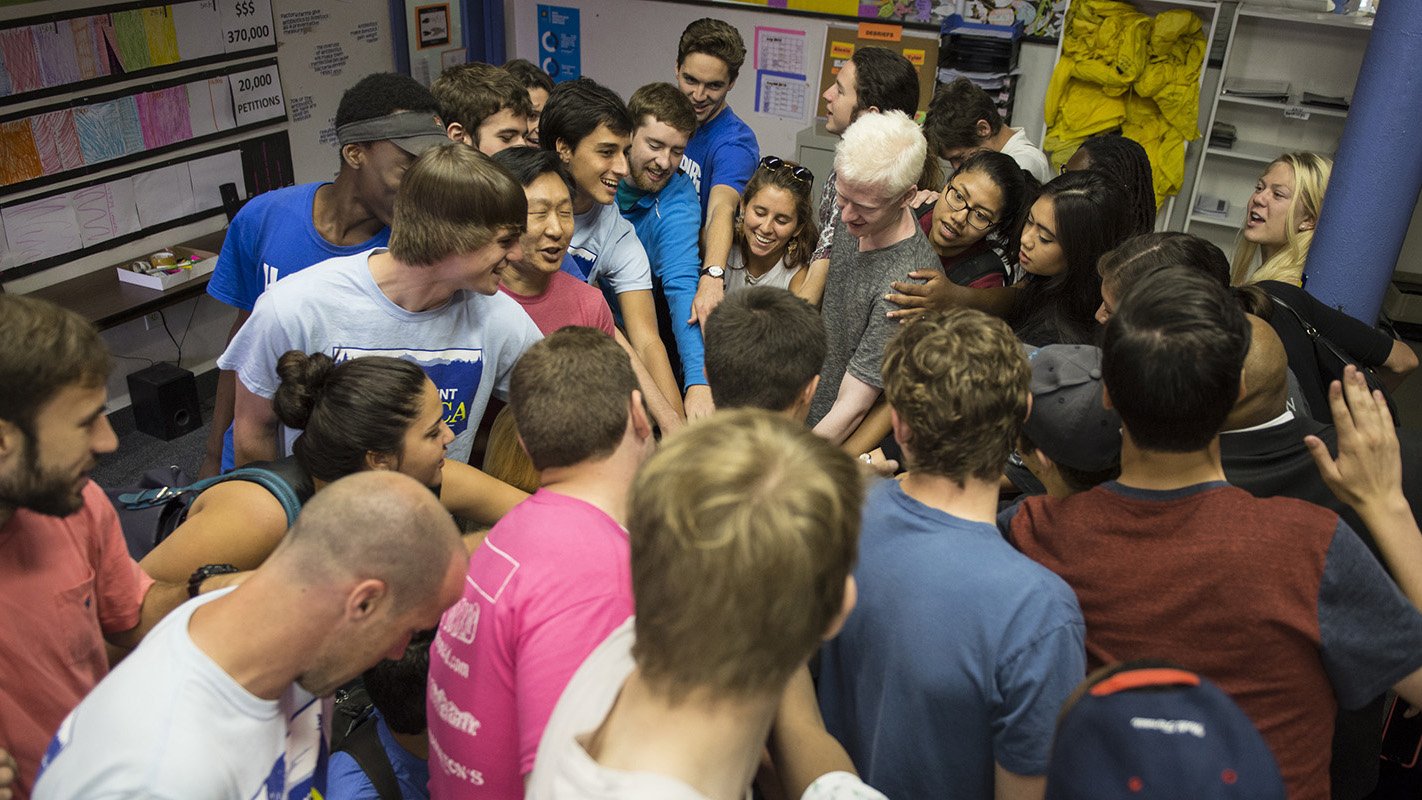
Members make the difference
PIRG and Fund canvassers have never stopped at pitching the person at the door to give money. Asking people to take action on the issues has been a hallmark of our approach to canvassing from the beginning.
Over the years, an estimated 16.5 million people have made donations to PIRG network groups; almost all of them have signed a petition or postcard to decision-makers. Another 3 million people declined to give, but still took action.
By canvassing on campaigns with broad support, a puncher’s chance of victory, and a theory that grassroots action could tip the balance in our favor, the Fund has helped win a stronger federal Clean Air Act (1990), the Roadless Rule that protects wild national forests (2000), and the California Global Warming Solutions Act (defended on the ballot in 2010), among dozens of other victories.
n short, because some 150,000 canvassers knocked on 120 million doors — walking from one door to the next, night after night after night, year after year after year — more people are breathing cleaner air, exploring wilder forests, reducing carbon emissions, and otherwise living healthier, safer lives in a cleaner, greener world.
Saving the Arctic
Among the millions of people the Fund has canvassed, few if any have ever visited the Arctic National Wildlife Refuge.
The Fund and its PIRG partners believed, however, that the Arctic Refuge was so ecologically important, its symbolism as one of the planet’s last truly wild places so powerful, that average Americans would rally to protect it against the oil industry’s attempts to drill there.
In the summers of 2004 and 2005, led by then-national canvass director Ed Johnson, Fund canvassers knocked on doors across the country, raising awareness of and mobilizing people to act to protect the Arctic Refuge from the threat posed by drilling.
On Dec. 21, 2005, in a dramatic 48-45 vote, our Arctic defender allies in Congress blocked a provision that would have opened the refuge to drilling. PIRG advocates, as well as others in our coalition, delivered the victory. But the members we canvassed made it possible.
Banning the bag
In the face of a growing trash crisis, in 2012 Fund canvassers began going door to door on behalf of Environment California to build support for a ban on single-use plastic grocery bags.
“Nothing we use for a few minutes should be allowed to pollute our oceans for hundreds of years,” canvassers echoed at door after door across the state.
By 2014, at least 140 California counties, cities and towns had banned single-use plastic bags, representing a third of the state’s population. By Sept. 30 of that year, our canvassers had gathered enough support to convince a majority of state lawmakers and Gov. Jerry Brown to pass and sign the nation’s first statewide bag ban law.
Since then, eight more states have banned single-use plastic bags; seven other states have banned single-use plastic foam cups and containers; and two states have adopted producer responsibility laws that discourage plastic waste of all kinds. As of 2022, 33% of Americans live in a state with a robust ban on some type of single-use plastics.
Citizen members, and the canvassers who recruited them, made the achievement possible.
Reducing the overuse of antibiotics
The routine use of medically important antibiotics in the food chain adds fuel to the risk of an antibiotic-resistant superbug sweeping the nation.
In 2014, PIRG launched our campaign to reduce the overuse of antibiotics in the poultry and livestock industries. Fund canvassers spoke to Americans about changing the way some of the largest restaurant chains in the world cultivate their food.
In 2017, after nearly 475,000 people signed our petition, KFC agreed to stop serving chicken raised on medically important antibiotics.
In 2018, the Fund educated citizens on the issue in 18 states. By summer’s end, canvassers knocked on more than 450,000 doors, mobilizing nearly 80,000 citizens to join our campaign calling on McDonald’s — the biggest purchaser of beef in the country — to stop misusing antibiotics in its supply chain.
By 2019, the voices our canvassers elevated convinced McDonald's to restrict medically important antibiotics in its beef supply chain — a move that could transform the way meat in this country is raised.
Photo credit: Pixabay.com

The canvass gathered "photo petitions" from supporters of the California plastic bag ban.

Ed Johnson was our national canvass director from 2003 - 2007, when he became national citizen outreach director, managing all of our citizen outreach programs, including canvass, telephone outreach and direct mail.
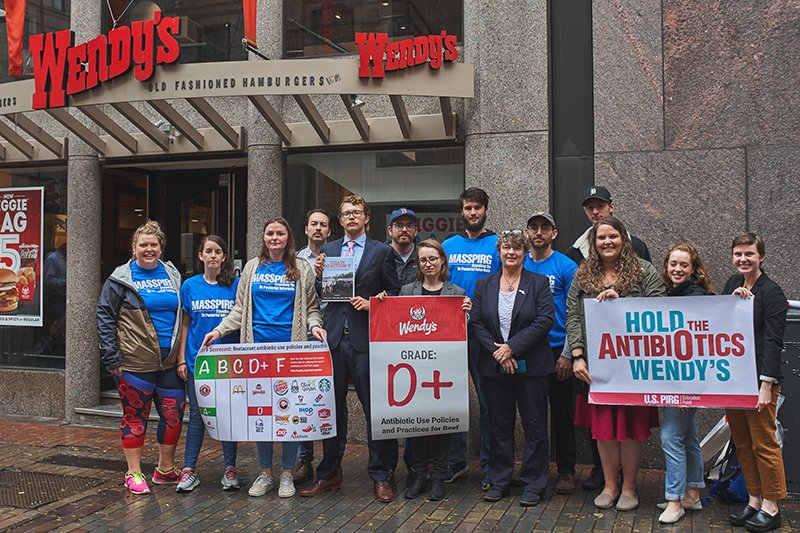
MASSPIRG canvass staff. By staff

An audacious proposition
The value proposition behind canvassing is audacious – to change the world, one conversation at a time.
It’s a proposition at odds with several dominant strains in 21st century American culture, pitting the noble but hard, laborious slog of building grassroots support against the desire for instant gratification; person-to-person contact against the digitization of everything; and the effort to unite people in a common cause against an increasingly polarized and atomized populace.
And yet thanks to the vision and determination (and many 80- to 100-hour weeks) of a long line of leaders – from Sandy Pooler and Susan Birmingham, to Jon Scarlett and Larry Eason and Julie Peters, to Hyam Kramer and Nancie Koenigsberg and Pat Wood, to Ed Johnson and Sarah Gaudette, to Adam Rothschild and Emily Reid – the Fund’s citizen outreach work has endured.
An institutional legacy
The legacy of the Fund’s citizen outreach work includes:
PIRG, including U.S. PIRG and the state PIRGs, many of which would not exist today were it not for the Fund canvass.
Environment America and the state environmental groups, the founding of which was made possible by the Fund’s ability to run and manage canvass offices for multiple groups at one time.
New members for a range of partner groups, including Sierra Club, Greenpeace, Human Rights Campaign, the Southern Utah Wilderness Alliance and others.
The Fund has also spawned a cultural legacy.
Talk to any group of citizen activists or professional advocates in the country, and you’re bound to find more than a few who canvassed for a summer or winter, or perhaps even a month or a week.
Those former canvassers (though, as with the Marines, some might argue that there’s no such thing as a former canvasser) are more likely to move without hesitation to take on the hardest tasks, to keep at it a little longer, and to put aside whatever shyness or nervousness and just get out there and talk to people.
Hang out with them a while longer, and they may even regale you with their stories of “pizza nights,” encounters with unfriendly dogs or other surprises (some good, some not so much) at the door, and mishaps with canvass cars, canvass office landlords and more. They’re people who will “eat dirt if they have to” in order to achieve their goals for the common good, and have fun talking about it later.
“The shared knowledge of that experience is like a secret handshake for people of all types,” said Kirk Weinert, a senior writer for the network. “Anyone who been a part of the canvass – for years or a single day, racing to the next door, doing a briefing, taking a job call, handling payroll – is part of what Kurt Vonnegut referred to as a karass: ‘a group of people linked in a cosmically significant manner, even when superficial linkages are not evident.”
There are tens of thousands of people who have canvassed for the Fund, Grassroots Campaigns and other outfits across the country – people who, whether they are professional advocates or activists in their free time – are willing to step outside, knock on a stranger’s door, and ask if they have a minute to join us in making the world a better place.
Photo credits: Top left, Eliott Foust, Wefoust Photo. Bottom middle, Adam Perri. All others by staff.

Current Director of Outreach and Civic Engagement Doug Casler (right), shown in 1987 with WashPIRG's Parker Blackman. Photo by staff
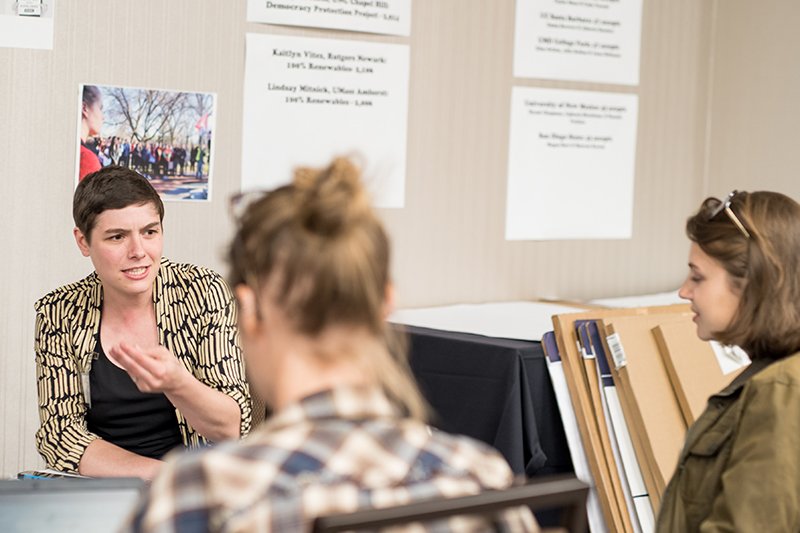
National Canvass Director Emily Reid (left) training staff. Photo by Oliver Rogers
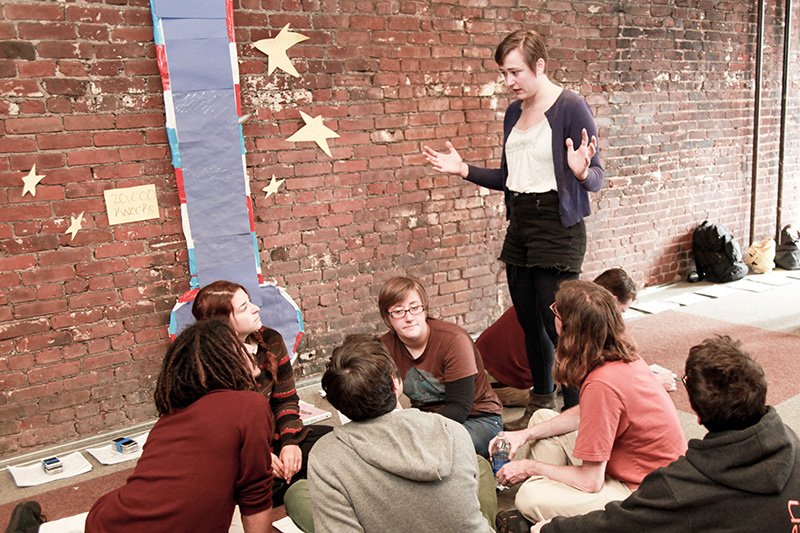
National Telephone Outreach Director Kyle Larson working with a citizen outreach team. Photo by Kimball Nelson


